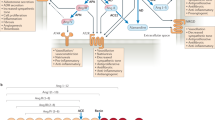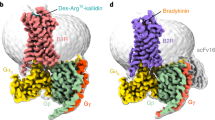Summary
Kinins are ubiquitous mediators that produce many of the cardinal manifestations of inflammation, and for that reason are an important target for therapeutic intervention. The cellular effects produced by the vasoactive kinin peptides are mediated by at least 2 different classes of receptors, B1 and B2. The development of specific, competitive antagonists of these receptors has provided a powerful tool for elucidating the physiopathological actions of kinins.
Considerable evidence from in vitro and animal studies suggests that currently available kinin antagonists are capable of blocking many of the pro-inflammatory effects of kinins. Studies to date in humans are encouraging, but not conclusive. The next few years should provide much information on the clinical potential of this exciting new class of components.
Similar content being viewed by others
References
Bhoola KD, Figueroa CD, Worthy K. Bioregulation of kinins: kallikreins, kininogens, and kininases. Pharmacol Rev 1992; 44(1): 1–80
Riccioppo Neto NF, Corrado AP, Rocha e Silva M. Apnea, bradycardia, hypotension and muscular contraction induced by intracarotid injection of bradykinin. J Pharmacol Exp Ther 1974; 190: 316–26
Figueroa CD, MacIver AG, Bhoola KD. Identification of immunoreactive tissue kallikrein in human polymorphonuclear leucocytes. Br J Haematol 1989; 72: 321–8
Figueroa CD, Henderson LM, Kaufmann J, et al. Immunovisualization of high (HK) and low (LK) molecular weight kininogens on isolated human neutrophils. Blood 1992; 79(3): 754–9
Henderson LM, Figueroa CD, Muller-Esterl W, et al. Assembly of contact phase factors on the surface of the human neutrophil membrane. Blood 1994; 84(2): 474–82
Rehbock J, Buchinger P, Herman A, et al. Identification of immunoreactive tissue kallikrein in human ductal breast carcinomas. J Cancer Res Clin Oncol 1994; 121: 64–8
McEachern AE, Sheton ER, Bhakta S, et al. Expression cloning of the rat B2 kinin receptor. Proc Natl Acad Sci USA 1991; 88: 7724–8
Hess JF, Borkowski JA, Stonesifer GY, et al. Molecular biology of bradykinin receptors. Can J Physiol 1994; 72(2): 17
Regoli D, Jukic D, Gobeil F, et al. Receptors for bradykinin and related kinins: a critical analysis. Can J Physiol Pharmacol 1993; 71: 556–67
Farmer SG, Burch RM, Kyle DJ, et al. D-Arg[Hyp3- Thi5-D-Tic]-Tic8]-bradykinin, a potent antagonist of smooth muscle BK2 receptors and BK3 receptors. Br J Pharmacol 1991; 102(4): 785–7
Stewart JM, Vavrek RJ. Bradykinin competitive antagonists: design and activities. Adv Biosci 1987; 65: 73–80
Pongracic JA, Naclerio RM, Reynolds CJ, et al. A competitive kinin receptor antagonist, [DArg0, Hyp3, DPhe7]-bradykinin, does not affect the response to nasal provocation with bradykinin. Br J Clin Pharmacol 1991; 31: 287–94
Hock FJ, Wirth K, Albus U, et al. New, long-acting, potent and long acting bradykinin-antagonist: in vitro studies. Br J Pharmacol 1991; 102: 769–73
Lembeck F, Griesbacher T, Eckhardt M, et al. New, long-acting, potent bradykinin antagonist. Br J Pharmacol 1991; 102: 297–304
Cheronis JC, Whalley ET, Nguyen KT, et al. A new class of bradykinin antagonists: synthesis and in vitro activity of bissuccininimidoalkine peptide dimers. J Med Chem 1992; 35(9): 1563–72
Cheronis JC, Whalley ET, Blodgett JK. Bradykinin antagonists: synthesis and in vitro activity of bissuccinimidoalkane peptide dimers. Agents Actions 1992; 1(Suppl.): 551–8
Kyle DJ, Martin JA, Burch RM, et al. Probing the bradykinin receptor: mapping the geometric topography using ethers of hydroxyproline in novel peptides. J Med Chem 1991; 34: 2649–53
Regoli D, Rhaleb NE, Tousignant C, et al. New highly potent bradykinin B2 receptor antagonists. Agents Actions 1991; 34Suppl. 1-2: 138–41
Cheronis JC, Whalley ET, Allen LG, et al. Design, synthesis and in vitro activity of bis(succinimido)hexane peptide heterodimers and combined B1 and B2 antagonist activity. J Med Chem 1994; 37: 348–55
Whalley ET, Solomon JA, Modafferi DM, et al. CP-0127, a novel potent bradykinin antagonist, increases survival in rat and rabbit models of endotoxin shock. Agents Actions 1992; 38Suppl. 3: 413–20
Christopher TA, Ma X-T, Gauthier TW, et al. Beneficial actions of CP-0127, a novel bradykinin receptor antagonist, in murine traumatic shock. Am J Physiol 1994; 266(3 part 2): H867–73
Griesbacher T, Tiran B, Lembeck F. Pathological events in experimental acute pancreatitis prevented by the bradykinin antagonist Hoe 140. Br J Pharmacol 1993; 108: 405–11
Bone RC, Balk RA, Cerra FB, et al. Definitions for sepsis and organ failure and guidelines for the use of innovative therapeutics in sepsis. Chest 1992; 101(6): 1644–55
Bone RC. The systemic inflammatory response syndrome: does the new name mean new therapies? Clin Immunother 1994; 1(5): 369–77
Naidoo Y, Snyman C, Narotam PK, et al. Release of the kinin moiety from kininogen on the other surface of the circulating neutrophil in patients with sepsis: peptides and their antagonists in tissue injury. Can J Physiol Pharmacol 1994; 72(2): 40
Scharschmidt LA, Whalley E, Fein AM, et al. Preclinical and clinical studies with CP-0127, a bradykinin antagonist. Can J Physiol Pharmacol 1994; 72(2): 18
Proud D, Togias A, Naclerio RM, et al. Kinins are generated in vivo following nasal airway challenge of allergic individuals with allergen. J Clin Invest 1983; 72: 1678–85
Scholkens BA, Heitsch H, Wirth. Kinin receptor antagonists: unique probes in basic and clinical research. Can J Physiol Pharmacol 1994; 72(2): 40
Poblete MT, Garces G, Figueroa CD, et al. Localization of immunoreactive tissue kallikrein in the seromucous glands of the human and guinea-pig respiratory tree. Histochem J 1993; 25: 834–9
Farmer SG. Role of kinins in airway diseases. Immunopharmacology 1991; 22: 1–20
Abraham WM. The potential role of bradykinin antagonists in the treatment of asthma. Agents Actions 1992; 38Suppl. 3: 439–49
Bhoola KD, Elson CJ, Dieppe PA. Kinins - key mediators in inflammatory arthritis? Br J Rheumatol 1992; 31(8): 509–18
Figueroa CD, MacIver AG, Mackenjie JC, et al. Localization of immunoreactive kininogen and tissue kallikrein in the human nephron. Histochemistry 1988; 89: 437–42
Moodley D, Snyman C, Naicker R, et al. Immunolocalisation of atrial natriuretic peptide and tissue kallikrein in the transplanted kidney during acute rejection [abstract]. Kidney Int. In press
Snyman C, Naidoo Y, Narotam PK, et al. Cellular localization of atrial natriuretic peptide and tissue kallikrein in the human hypothalamus. Braz J Med Biol Res 1994; 27(8): 1877
Neppl H, Neuhof H, Afflerbach F, et al. Bradykinin induced edema formation proceeds from B2 receptor stimulation and is potentiated by concomitantly released prostaglandins. Acta Physiol Scand 1991; 142(2): 141–7
Unterberg A, Baethman AJ. The kallikrein-kinin system as mediator in vasogenic brain edema. Part 1: cerebral exposure to bradykinin and plasma. J Neurosurg 1984; 61: 87–96
Maier-Hauff K, Baethmann AJ, Lange M, et al. The kallikrein-kinin system as mediator in vasogenic brain edema. Part 2: studies on kinin formation in focal and perifocal brain tissue. J Neurosurg 1984; 61: 97–106
Unterberg A, Dautermann C, Baethmann A, et al. The kallikrein-kinin system as mediator in vasogenic brain edema. Part 3: inhibition of the kallikrein-kinin system in traumatic brain swelling. J Neurosurg 1986; 64: 269–76
Author information
Authors and Affiliations
Rights and permissions
About this article
Cite this article
Rodell, T.C., Naidoo, Y. & Bhoola, K.D. Role of Kinins in Inflammatory Responses. Clin. Immunother. 3, 352–361 (1995). https://doi.org/10.1007/BF03259501
Published:
Issue Date:
DOI: https://doi.org/10.1007/BF03259501




